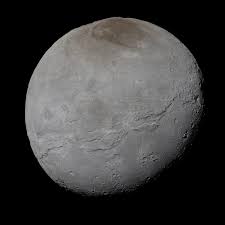Charon Moon:

Scientists have recently detected carbon dioxide and hydrogen peroxide on Charon, Pluto’s largest moon, using the James Webb Space Telescope (JWST).
- Charon is the largest of Pluto’s five moons, roughly half the size of Pluto itself.
- It was discovered on June 22, 1978, by James W. Christy and Robert S. Harrington at the U.S. Naval Observatory in Flagstaff, Arizona.
- Charon is about 1,214 kilometers (754 miles) in diameter, and its mass is more than one-tenth of Pluto’s mass.
- Due to its size and mass relative to Pluto, they are often referred to as a double dwarf planet system.
- Charon and Pluto always show the same face to each other, a phenomenon known as mutual tidal locking.
- Charon orbits Pluto every 6.4 Earth days at a distance of about 19,640 kilometers (12,200 miles).
- Recent findings include carbon dioxide and hydrogen peroxide, in addition to previously known substances like water ice and ammonia-bearing compounds.
- Charon is located in the Kuiper Belt and serves as an invaluable target for studying icy bodies beyond Neptune’s orbit.




